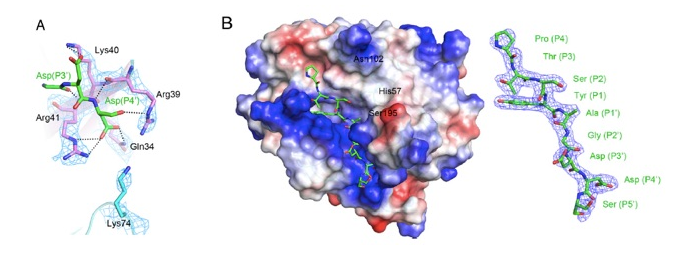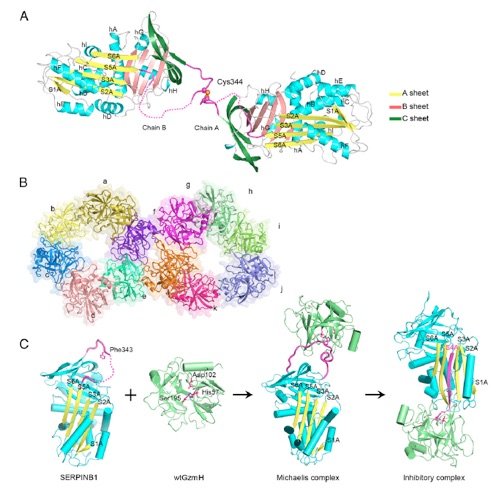Structure and function of granzymes secreted from NK cells
(In collaboration with Prof. Zusen Fan, IBP)
1. Structural basis for proteolytic specificity of the human apoptosis-inducing granzyme M.

Granzyme M (GzmM), a unique serine protease constitutively expressed in NK cells, is important for granule-mediated cytolysis and can induce rapid caspase-dependent apoptosis of tumor cells. However, few substrates of GzmM have been reported to date, and the mechanism by which this enzyme recognizes and hydrolyzes substrates is unknown. To provide structural insights into the proteolytic specificity of human GzmM (hGzmM), crystal structures of wild-type hGzmM, the inactive D86N-GzmM mutant with bound peptide substrate, and the complexes with a catalytic product and with a tetrapeptide chloromethylketone inhibitor were solved to 1.96 ?, 2.30 ?, 2.17 ? and 2.70 ?, respectively. Structure-based mutagenesis revealed that the N terminus and catalytic triad of hGzmM are most essential for proteolytic function. In particular, D86N-GzmM was found to be an ideal inactive enzyme for functional studies. Structural comparisons indicated a large conformational change of the L3 loop upon substrate binding, and suggest this loop mediates the substrate specificity of hGzmM. Based on the complex structure of GzmM with its catalytic product, a tetrapeptide chloromethylketone inhibitor was designed and found to specifically block the catalytic activity of hGzmM.
Reference:
Wu L., Wang L., Hua G., Liu K., Yang X., Zhai Y., Bartlam M., Sun F*. and Fan Z.* (2009) Structural Basis for Proteolytic Specificity of the Human Apoptosis-Inducing Granzyme M, The Journal of Immunology, 183. 421-9.
2. Structural insights into the substrate specificity of human granzyme H - the functional roles of a novel RKR motif.

Human granzyme H (GzmH) is constitutively expressed in human NK cells that have important roles in innate immune responses against tumors and viruses. GzmH is a chymotrypsin-like serine protease. Its substrate preference and its mechanism of substrate recognition are poorly understood. To provide structural insights into the substrate recognition mechanisms for GzmH, we solved the crystal structures of a D102N-GzmH mutant alone and in complex with a decapeptide substrate and an inhibitor to 2.2 ?, 2.4 ? and 2.7 ?, respectively. The Thr189. Gly216 and Gly226 specificity triad in the S1 pocket of GzmH defines its preference for bulky, aromatic residues (Tyr and Phe) at the P1 position. Notably, we discovered that an unusual RKR motif (Arg39-Lys40-Arg41), conserved only in GzmH, helps define the S3’ and S4’ binding regions, indicating the preference for acidic residues at the P3’ and P4’ sites. Disruption of the RKR motif or the acidic P3’ and P4’ residues in the substrate abolished the proteolytic activity of GzmH. We designed a tetrapeptide chloromethylketone (CMK) inhibitor, Ac-PTSY-CMK, which can selectively and efficiently block the enzymatic and cytotoxic activity of GzmH, providing a useful tool for further studies on the function of GzmH.
Reference:
Wang Li, Zhang Kai, Wu Lianfeng, Liu Shengwu, Zhang Honglian, Zhou Qianjun, Tong Liang, Sun Fei* and Fan Zusen*. Structural Insights into the substrate specificity of human granzyme H - the functial roles of a novel RKR motif. The Journal of Immunology,188(2): 765-73.
3. Identification of SERPINB1 as a physiological inhibitor of human granzyme H.

The granzyme/perforin pathway is a major mechanism for cytotoxic lymphocytes to eliminate virus-infected and tumor cells. The balance between activation and inhibition of the proteolytic cascade must be tightly controlled to avoid self damage. Granzyme H(GzmH) is constitutively expressed in NK cells and induces target cell death; however, how GzmH activity is regulated remains elusive. We reported earlier the crystal structures of inactive D102N-GzmH alone and in complex with its synthetic substrate and inhibitor, as well as defined the mechanisms of substrate recognition and enzymatic activation. In this study, we identified SERPINB1 as a potent intracellular inhibitor for GzmH. Upon cleavage of the reactive center loop at Phe343. SERPINB1 forms an SDS-stable covalent complex with GzmH. SERPINB1 overexpression suppresses GzmH- or LAK cell–mediated cytotoxicity. We determined the crystal structures of active GzmH and SERPINB1 (LM-DD mutant) in the native conformation to 3.0- and 2.9-A ° resolution, respectively. Molecular modeling reveals the possible conformational changes in GzmH for the suicide inhibition. Our findings provide new insights into the inhibitory mechanism of SERPINB1 against human GzmH.
Reference:
Wang L., Li Q., Wu L., Liu S., Zhang Y., Yang X., Zhu P., Zhang H., Zhang K., Lou J., Liu P., Tong L.*, Sun F.* and Fan Z.*. (2013) Identification of SERPINB1 as a physiological inhibitor of human granzyme H. The Journal of Immunology, 190(3):1319-30. doi:10.4049/jimmunol.1202542.
附件下载: